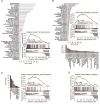Whole transcriptome analysis reveals a role for OGG1-initiated DNA repair signaling in airway remodeling
- PMID: 26187872
- PMCID: PMC4924473
- DOI: 10.1016/j.freeradbiomed.2015.07.007
Whole transcriptome analysis reveals a role for OGG1-initiated DNA repair signaling in airway remodeling
Abstract
Reactive oxygen species (ROS) generated by environmental exposures, and endogenously as by-products of respiration, oxidatively modify biomolecules including DNA. Accumulation of ROS-induced DNA damage has been implicated in various diseases that involve inflammatory processes, and efficient DNA repair is considered critical in preventing such diseases. One of the most abundant DNA base lesions is 7,8-dihydro-8-oxoguanine (8-oxoG), which is repaired by the 8-oxoguanine DNA glycosylase 1 (OGG1)-initiated base-excision repair (OGG1-BER) pathway. Recent studies have shown that the OGG1-BER by-product 8-oxoG base forms a complex with cytosolic OGG1, activating small GTPases and downstream cell signaling in cultured cells and lungs. This implies that persistent OGG1-BER could result in signaling leading to histological changes in airways. To test this, we mimicked OGG1-BER by repeatedly challenging airways with its repair product 8-oxoG base. Gene expression was analyzed by RNA sequencing (RNA-Seq) and qRT-PCR, and datasets were evaluated by gene ontology and statistical tools. RNA-Seq analysis identified 3252 differentially expressed transcripts (2435 up- and 817 downregulated, ≥ 3-fold change). Among the upregulated transcripts, 2080 mRNAs were identified whose encoded protein products were involved in modulation of the actin family cytoskeleton, extracellular matrix, cell adhesion, cadherin, and cell junctions, affecting biological processes such as tissue development, cell-to-cell adhesion, cell communication, and the immune system. These data are supported by histological observations showing epithelial alterations, subepithelial fibrosis, and collagen deposits in the lungs. These data imply that continuous challenge by the environment and consequent OGG1-BER-driven signaling trigger gene expression consistent with airway remodeling.
Keywords: 8-Oxoguanine; Airway remodeling; OGG1-BER.
Copyright © 2015. Published by Elsevier Inc.
Figures








Similar articles
-
Whole transcriptome analysis reveals an 8-oxoguanine DNA glycosylase-1-driven DNA repair-dependent gene expression linked to essential biological processes.Free Radic Biol Med. 2015 Apr;81:107-18. doi: 10.1016/j.freeradbiomed.2015.01.004. Epub 2015 Jan 19. Free Radic Biol Med. 2015. PMID: 25614460 Free PMC article.
-
Oxidized base 8-oxoguanine, a product of DNA repair processes, contributes to dendritic cell activation.Free Radic Biol Med. 2019 Nov 1;143:209-220. doi: 10.1016/j.freeradbiomed.2019.08.010. Epub 2019 Aug 10. Free Radic Biol Med. 2019. PMID: 31408726 Free PMC article.
-
8-Oxoguanine DNA glycosylase-1-mediated DNA repair is associated with Rho GTPase activation and α-smooth muscle actin polymerization.Free Radic Biol Med. 2014 Aug;73:430-8. doi: 10.1016/j.freeradbiomed.2014.03.030. Epub 2014 Mar 26. Free Radic Biol Med. 2014. PMID: 24681335 Free PMC article.
-
Repair of 8-oxo-7,8-dihydroguanine in prokaryotic and eukaryotic cells: Properties and biological roles of the Fpg and OGG1 DNA N-glycosylases.Free Radic Biol Med. 2017 Jun;107:179-201. doi: 10.1016/j.freeradbiomed.2016.11.042. Epub 2016 Nov 27. Free Radic Biol Med. 2017. PMID: 27903453 Review.
-
The role of 8-oxoguanine DNA glycosylase-1 in inflammation.Int J Mol Sci. 2014 Sep 23;15(9):16975-97. doi: 10.3390/ijms150916975. Int J Mol Sci. 2014. PMID: 25250913 Free PMC article. Review.
Cited by
-
Targeting inducible epigenetic reprogramming pathways in chronic airway remodeling.Drugs Context. 2019 Oct 23;8:2019-8-3. doi: 10.7573/dic.2019-8-3. eCollection 2019. Drugs Context. 2019. PMID: 31692901 Free PMC article. Review.
-
OGG1-DNA interactions facilitate NF-κB binding to DNA targets.Sci Rep. 2017 Mar 7;7:43297. doi: 10.1038/srep43297. Sci Rep. 2017. PMID: 28266569 Free PMC article.
-
Genetic overlap of chronic obstructive pulmonary disease and cardiovascular disease-related traits: a large-scale genome-wide cross-trait analysis.Respir Res. 2019 Apr 2;20(1):64. doi: 10.1186/s12931-019-1036-8. Respir Res. 2019. PMID: 30940143 Free PMC article.
-
8-Oxoguanine targeted by 8-oxoguanine DNA glycosylase 1 (OGG1) is central to fibrogenic gene activation upon lung injury.Nucleic Acids Res. 2023 Feb 22;51(3):1087-1102. doi: 10.1093/nar/gkac1241. Nucleic Acids Res. 2023. PMID: 36651270 Free PMC article.
-
Implications of DNA damage in chronic lung disease.Front Cell Dev Biol. 2024 Oct 31;12:1436767. doi: 10.3389/fcell.2024.1436767. eCollection 2024. Front Cell Dev Biol. 2024. PMID: 39544366 Free PMC article. Review.
References
-
- Bousquet J, Jeffery PK, Busse WW, Johnson M, Vignola AM. Asthma: from bronchoconstriction to airways inflammation and remodeling. Am J Respir Crit Care Med. 2000;161:1720–1745. - PubMed
-
- James AL, Wenzel S. Clinical relevance of airway remodelling in airway diseases. Eur Respir J. 2007;30:134–155. - PubMed
-
- Cooke MS, Evans MD, Dizdaroglu M, Lunec J. Oxidative DNA damage: mechanisms, mutation, and disease. FASEB J. 2003;17:1195–1214. - PubMed
-
- Steenken S, Jovanovic S. How easily oxidizable is DNA? One-electron reduction potentials of adenosine and guanosine radicals in aqueous solution. J Am Chem Soc. 1997;119:617–618.
-
- Cadet J, Douki T, Gasparutto D, Ravanat JL. Oxidative damage to DNA: formation, measurement and biochemical features. Mutat Res. 2003;531:5–23. - PubMed
Publication types
MeSH terms
Substances
Grants and funding
LinkOut - more resources
Full Text Sources
Other Literature Sources
Molecular Biology Databases
Research Materials

